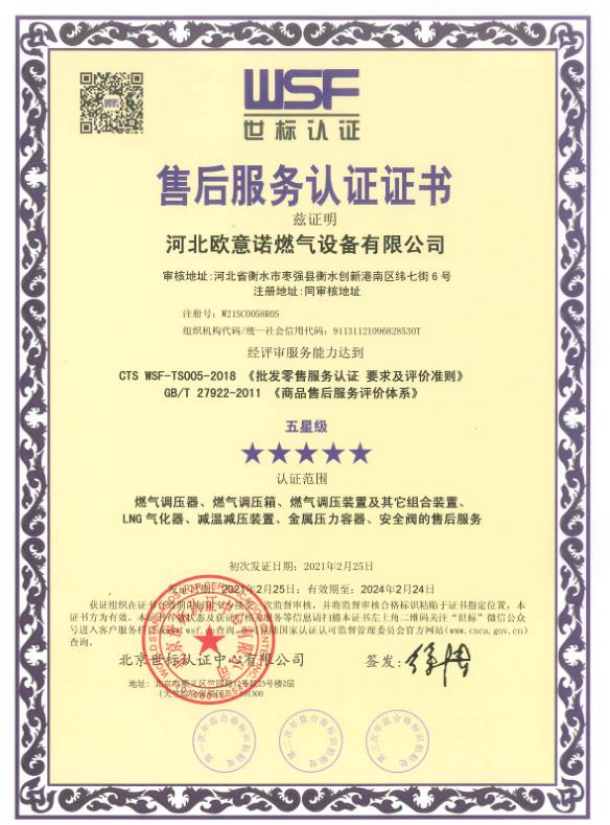
7 月 . 31, 2024 16:59
Back to list
Understanding Gas Pressure Regulation Valves and Their Importance in Industrial Applications
Understanding Gas Pressure Regulators
Gas pressure regulators are crucial devices that play a vital role in various applications, from residential heating systems to industrial processes. These regulators are designed to maintain a constant output pressure, ensuring that the gas supply remains stable and safe for use. This article will delve into the functions, types, and importance of gas pressure regulators.
What is a Gas Pressure Regulator?
At its core, a gas pressure regulator is a mechanical device that reduces the pressure of the incoming gas to a predetermined output pressure. This is particularly important because gases are often supplied at relatively high pressures, which can be dangerous if not managed properly. By regulating the pressure, the device helps prevent potential accidents, such as leaks or explosions, that can occur if the pressure is too high.
How Does a Gas Pressure Regulator Work?
The working principle of a gas pressure regulator involves a balance between the incoming gas pressure and the force exerted by a spring inside the device. When gas flows into the regulator, it pushes against the diaphragm, which is connected to the spring. As the pressure increases or decreases, the diaphragm moves, adjusting the valve’s opening to maintain the set pressure. This feedback loop ensures that the output pressure remains consistent, regardless of variations in the input pressure or flow rate.
.
There are several types of gas pressure regulators, each designed for specific applications
صمام تنظيم ضغط الغاز

1. Single-Stage Regulators These are generally used for applications where a consistent outlet pressure is required, but pressure fluctuations are minimal. They are easy to install and maintain but may not be suitable for high-demand scenarios.
2. Two-Stage Regulators These regulators are designed to handle larger fluctuations in incoming pressure. They provide a more stable output pressure by first reducing the incoming pressure in a primary stage before further regulating it in a secondary stage. This type is commonly used in residential and commercial applications.
3. Automatic and Manual Regulators Automatic regulators adjust the output pressure without requiring manual intervention, making them ideal for modern gas supply systems. Manual regulators, on the other hand, require users to adjust the pressure settings as needed.
Importance of Gas Pressure Regulators
The importance of gas pressure regulators cannot be overstated. Firstly, they enhance safety by preventing excessive pressure buildup, reducing the risk of leaks, and ensuring safe operation of appliances and industrial equipment. Secondly, they improve efficiency. By maintaining a consistent pressure, gas appliances can operate optimally, ensuring that they burn fuel more completely and effectively.
Furthermore, gas pressure regulators contribute to cost savings. By regulating pressure accurately, they help reduce gas consumption, which can lower utility bills for both residential and commercial users. Additionally, they extend the lifespan of gas appliances by preventing damage that can result from pressure fluctuations.
Conclusion
In conclusion, gas pressure regulators are essential components of any gas supply system, ensuring safe and efficient operation. Their ability to maintain a consistent output pressure plays a critical role in preventing accidents, enhancing efficiency, and saving costs. As technology continues to evolve, so too will the design and functionality of these devices, making them even more integral to our daily lives and industries. Understanding their significance is key to appreciating the safety and efficiency of gas utilization in our homes and businesses.
Latest news
-
Unlocking The Quality Gas Pressure ReducersNewsNov.01,2024
-
The Role of Gas Pressure Reducing StationsNewsNov.01,2024
-
The Importance and Functionality of Safety Relief ValvesNewsNov.01,2024
-
The Essential Role of Safety Valves in Natural Gas ApplicationsNewsNov.01,2024
-
The Essential Role of Gas Pressure RegulatorsNewsNov.01,2024
-
Enhance Your Premium Gas FiltersNewsNov.01,2024

